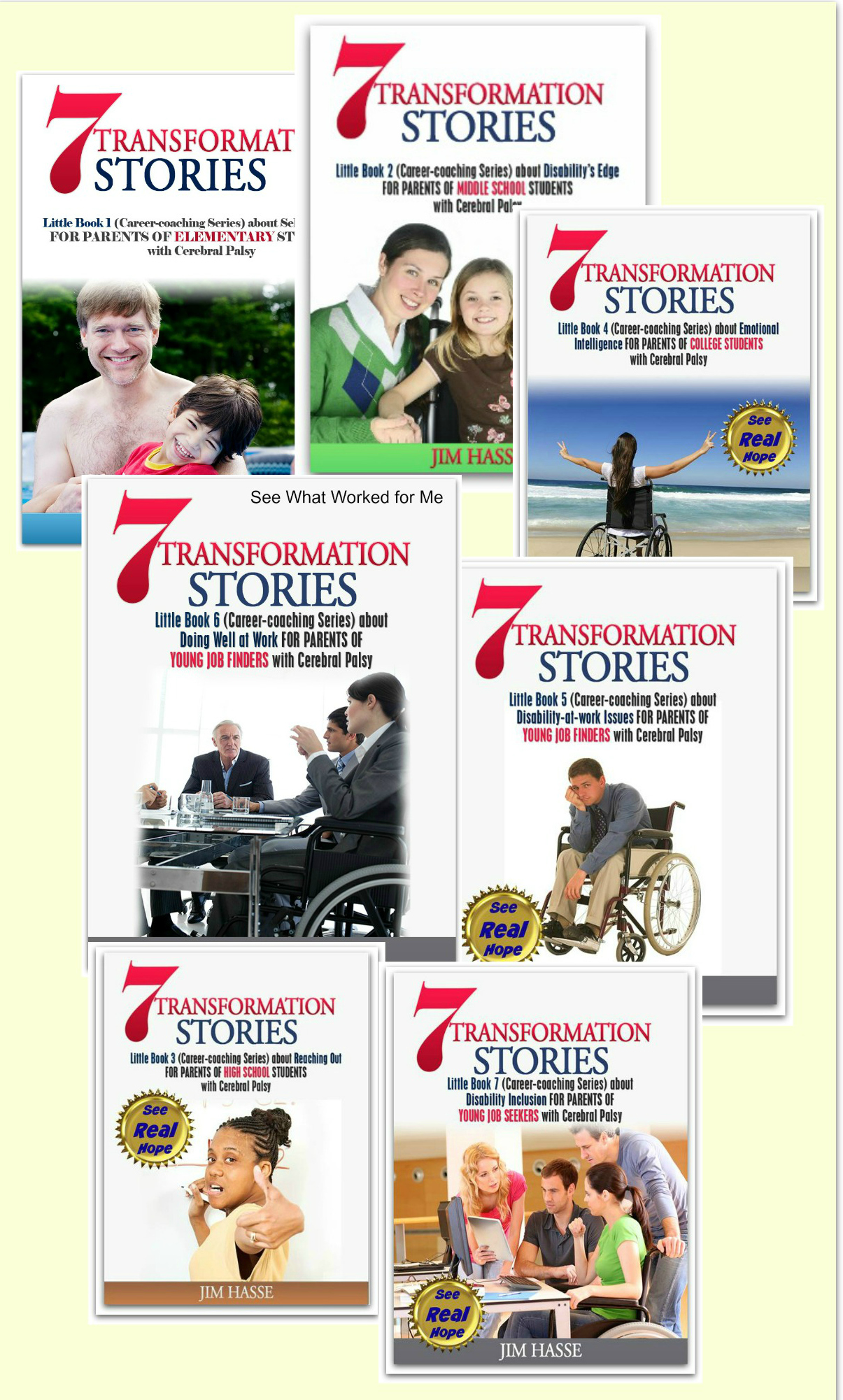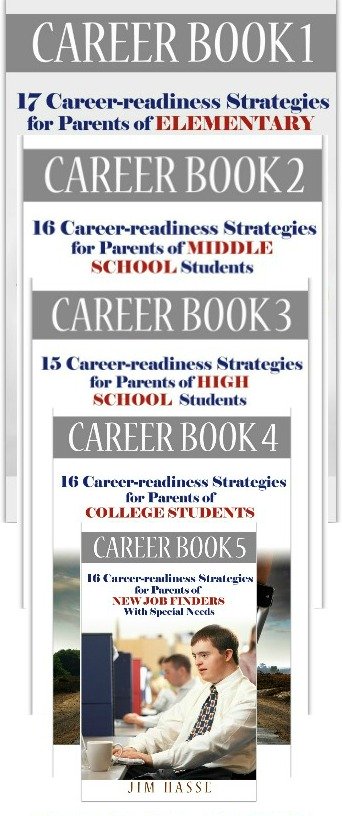Career
Test: Cerebral Palsy Career Building Steps for Middle School Students
By Jim Hasse, ABC, GCDF, Disability Employment Expert
_________________________________________________________
The career test for your middle school youngster with cerebral palsy (CP) is taking 20 career building steps -- all based on the road map (see my 20 articles) outlined by National Career Development Guidelines.
I didn’t get what I consider my true career test (my Myers-Briggs personality profile) until much later in life.
I was 35 in 1978. By that time, I was emerging as a manager of a corporate communication department, hiring professionals as well as high school and summer interns to do the “hands-on” work I had been doing as a “one-person department” for 13 years.
To my surprise (and relief), I had fallen into an occupation that fits nicely with my temperament (despite my physical disabilities): using writing as a means of communication. I had unknowingly “done well” on my career test, one of the first instruments a career counselor usually provides a student or client, without even taking it when I was in seventh or eighth grade.
I’m an INFJ, one of 16 temperament styles Dr. David Keirsey and Dr. Marilyn Bates, California State University (Fullerton), identified in “Please Understand Me” (Premetheus Nemesis Books,1978).
According to my temperament type, I place people and their concerns as being the highest priority in any situation. I’m empathetic, intuitive, enjoy “possibility thinking” and creativity and can “read” other people accurately. But, I’m also a perfectionist and, at times, too demanding of others (check particularly with Pam, my wife). I’m not a visible leader but prefer to influence events behind the scenes. I’m a rather private person.
The bottom line is that my Myers-Briggs career test shows I’m good at public relations and interpersonal relationships. And, in surprising ways, my temperament and hard-won capabilities seem to (in some ways) complement and (in other ways) over-ride my vulnerabilities.
For instance, as a manager (and later vice president) of a corporate communication department for a Fortune 500 company, I was perfectly comfortable with delegating unusual authority (and giving accolades) to individuals on my staff. These were abled people who, for instance, spoke more effectively and who conducted a photo shoot more effectively than I could.
Did I plan my career based on my temperament style? No. When I first started working, I didn't know what a career test was.
Looking back, that now scares the willies out of me. What if I had decided to an accountant? Knowing what I know now about career test options, I would have been frustrated in my work and bored to death.
The Importance of happenstance
According to a series of Gallup Polls in the 1980s and 1990s, more than 70 percent of working adults wish they could start over. If they could, they would use more and better information in making their decisions.
But, somehow, for me, the right things fell in the right places at the right time. Career theorist Dr. John D. Krumboltz calls it “happenstance learning theory” – that we should be open to future career opportunities that will come our way that we can’t even imagine right now.
I can relate to happenstance. Who wants to be bogged down by the results of one career test anyway?
At birth, I was dealt a handful of cards that didn't add up to much at the time. My brain injury could have left me deaf, speechless, spastic beyond any control or mentally disabled. The capabilities, both mentally and physically, I received at birth depended on what portion of my brain was damaged.
Happenstance gave me an unusual combination of muscles that are, in some cases, too relaxed and, in other instances, too rigid; a set of motor skills that are severely affected but not too limiting; and a degree of intelligence that was not touched by my birth injury.
So, the chances of developing a somewhat "normal" life were slim, possible but not probable. But, that's what kept me in the game: the element of surprise.
What is particularly surprising to me that, as part of my “second” career, I find myself writing to you, a mom who wants to coach your youngster with CP in building a meaningful career.
I need to quote what Keirsey and Bates write in their book about people like me who are INFJs:
“Their great talent for language usually is directed toward people, describing people and writing to communicate with people in a personalized way … As therapists, INFJs may choose counseling, clinical psychology or psychiatry or may choose to teach in those fields. Writing about those professions often intrigues an INFJ.”
I’m amazed that I’m again inadvertently taking another step that is in line with my temperament style.
So, I am communicating with you about how to be a career-builder mom in cyberspace -- an opportunity that would have been a “pipe dream” for me in 1978 when I had no concept of career counseling or disability employment issues or the Internet. At the time, I was focused on building a staff and helping my CEO gain believability and trust among the various stakeholders of our organization.
But, 16 years later, I was ready to “jump ship” and start a new career in what I thought was to be helping college students with disabilities prepare for the mainstream-work world I had known for almost 29 years.
Based on experience (my own career test), I now know how I can best devote my energies in raising the employment level of individuals with disabilities: showing you what I have learned about what works (and does not work) in helping your youngster with CP build a meaningful career.
What your middle school student must recognize
According to the National Career Development Guidelines (NCDG), these are the 11 career development competencies your youngster can develop at the “knowledge acquisition” level during middle/junior high school:
- Recognize that understanding
one’s personal interests, likes, and dislikes is a step toward building
and maintaining a positive self-concept.
- Identify respect for
diversity as an essential positive interpersonal skill.
- Recognize that growth and
change are essential parts of career development.
- Affirm the need for balance
among personal, leisure, community, learner, family and work roles.
- Recognize that educational
achievement and performance levels are needed to reach personal and career
goals.
- Realize that ongoing,
lifetime learning enhances one’s ability to function well in a diverse and
changing economy.
- Describe why creating and
managing a career plan is essential to meeting career goals.
- Describe the process of making
decisions as one key aspect of career management.
- Recognize the importance of
accurate, current and unbiased career information in planning and managing
one’s career.
- Recognize the variety of
skills that are important for success and advancement in school and work,
such as communicating, critical thinking, and problem solving.
- Realize that changing employment trends, societal needs and economic conditions have an impact on one’s career path.
I follow the NCDG framework for each of these five stages in your youngster’s development:
- Elementary, when your
child becomes aware of job titles.
- Middle school, when your
youngster begins to appreciate individual personalities and preferences
among family and friends through a simple career test.
- High school, when your
youngster needs to start gaining work experience through part-time jobs.
- College, when your
youngster needs to master specific job seeking skills, such as absorbing and
implementing interview tips.
- Job search, when your young son or daughter becomes a job finder by putting together job seeking skills into a comprehensive marketing campaign and career management approach that he or she can routinely update throughout a lifetime.
As your youngster progresses through each of these five developmental milestones, I’ll show you the barriers I personally encountered (and worked around) and the options you and your youngster can consider for your own “workarounds.”
20 articles: Middle school career builders
Specifically, I have divided the NCDG competencies for your middle school student into two sets of 10 disability-focused articles.
One set is based on self-confidence, and the other set is focused on competitive advantage for your middle school school youngster:
10 career builders which foster your youngster’s self-confidence. These include developing:
- Self concept (Personality Quiz, Career
Assessment Tests)
- Career mindedness (Inspirational Stories, Self-discipline)
- Decision making skills (Why People Work, Ticket to Work)
- Career information gathering
abilities (Assistive Technology
Devices, Telecommuting)
- Career path management skills (Mentoring Stories, Cheer and Support)
10 career builders which provide opportunities to discover a personal competitive edge. These include developing:
- Interpersonal communication
skills (Basic Interpersonal Communication, How to Improve Interpersonal Communication)
- Balance between work and
personal time (Setting and
Achieving a Goal, Crucial Technology)
- Educational and lifelong
learning orientations (How to
Choose a Career, Problem Solving Tools)
- Career trend tracking
abilities (Career Outlook
Information, Career
Building
Information)
- Job marketing skills (Cerebral Palsy Answers, Cerebral Palsy Story)
In essence, each of these career builders is a career test for your youngster with cerebral palsy during middle/junior high school.
Since 1997, I’ve met many accomplished people with CP who are successfully working within a wide variety of occupations. On this site, you’ll find their success stories (and how their parents and other mentors have helped them succeed).
Follow me, and you and your youngster with CP will also have the opportunity to share your views about specific mentoring issues as well as personal success stories with others facing some of your same challenges.
You'll have the opportunity to grow together within each of the above stages of
discovery and learning -- which is truly a career test.
Return from Career Test to Cerebral Palsy Career Builders.
This is Creative Commons content. You can freely and legally use, share and repurpose it for non-commercial purposes only, provided you attach this sentence and the following attribution to it (including the two links):
Originally written and illustrated by Jim Hasse, ABC, GCDF, owner of Hasse Communication Counseling, LLC, who, as a person with cerebral palsy, served for 10 years as a vice president in a Fortune 500 company during his 29-year career in corporate communication. He’s an Accredited Business Communicator, certified as a Global Career Development Facilitator and author of 14 Amazon books about disability awareness and disability employment issues.





